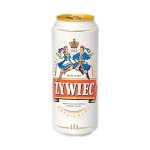Krakow’s 2010 March of “Tolerance”
This past Saturday I participated in the sixth annual March of Tolerance in Krakow, which is a march to raise awareness for sexual minorities. The event received very little media attention as far as I can see, but according to Radio ZET, there were around 500 participants that marched from Plac Wolnica in Kazimierz (the Jewish District) to the Market Square in the center of the old city. Krakow police reported that this year’s march was very calm and that there were no serious incidents.
From a Polish perspective the march may have seemed calm but it was an interesting experience for me as an American. In the past, I attended and participated in the Gay Pride Parade in Philadelphia, as well as other events organized by the GLBT community in my city. Certainly it is not fair to compare a liberal city in the United States with a smaller city in former-communist, Catholic Poland. However I am used to events in Philadelphia and the march in Poland seemed anything tolerant.
First I noticed a group of priests holding a cross on the grass outside of Wawel Castle. Policemen encircled the group, each with a German shepherd on a leash, lazily watching the priests pray for the parade participants. People watched as the parade walked towards the center, carrying signs, rainbow flags, and holding balloons. Some stood on balconies gawking out of their windows as the people walked past. Just before the market, nationalists threw eggs at the parade. Some shouted (according to the article, because I couldn’t understand all of the Polish yelling) “Boy, girl – a normal family!” and “We do not give you Krakow!” As the parade participants released the balloons at the end of the march, I watched a man who was standing with a priest that seemed to be his friend spit at one of the demonstrators holding a sign. However the most interesting thing for me to see was the sheer number of policemen that worked the event. The policemen, some holding large plastic shields or with tanks of gas on their back ready to control an unruly crowd, formed a tight wall between the marchers and the public. They intimidated me, dressed in all black like members of a SWAT team.
Looking at Poland’s homophobia in the past decade, one can understand why the police reported this year’s march was calm, despite the eggs and shouting. A decade ago, there were no politics of sexuality in Poland, and no one openly discussed any of these issues. The first “Equality Parade” in Poland took place in Warsaw in 2001, but received very little media coverage. As the community became more visible, the country reacted more strongly against it. In 2003, there was the “Let Them See Us” Campaign, which was an exhibit of thirty photographs that opened in five galleries around the country. The photographs featured same-sex couples in their everyday lives, holding hands, etc. The more controversial subjects such as marriage or adoption were avoided. Nevertheless, within days most of the photographs were destroyed, ripped, or painted over.
In 2004, violence erupted at the Krakow and Poznan equality marches. The extremely nationalist group All-Polish Youth and their supporters attacked the demonstrators by throwing rocks and punches, and even beating some with clubs. They chanted sayings like “labor camps for lesbians” or “faggots to the gas.” The police were unable to control the violence. In 2005, the “gay parade” and its legality was a huge topic during the presidential elections. Recently deceased Lech Kaczynski (elected president in October 2005) banned the 2004 and 2005 marches when he was mayor of the city of Warsaw. This decision strengthened his political career. The 2005 Equality March in Warsaw was held despite the ban, which ended up adding to the event’s popularity. Around 3,000 people participated, which was the largest march in the history of the movement. Later that year, the march in Poznan was also banned by the city’s major, but it was less peaceful. Again the All-Polish Youth group organized the attack, and they threw eggs, horse manure and slurs. As the crowd got out of control, the police ended up attacking the demonstrators rather than the attackers. A participant reported seeing a boy dragged by police with his head hitting the pavement, another person was dragged away from TV cameras when he was talking about police brutality, and many people were arrested without explanation. This time the media did cover the event, mostly criticizing the police brutality.
In January 2006, the EU Parliament passed a resolution against homophobia in Europe, which explicitly named Poland as a country where homophobia exists. Poland perceived this as an attack against the country’s religious and moral beliefs. Right-wing Polish members of the EU Parliament unanimously opposed this resolution, but it was passed anyway. In June 2006, the EU Parliament adopted a resolution in response to homophobic and racist violence in Europe, and again specifically named Poland mentioning groups like the All-Polish Youth. A survey from 2005 found 89% of the population stating that they considered homosexuality an “unnatural” activity. A Eurobarometer poll in 2006 found that 74% of Poles were opposed to same-sex marriage and 89% opposed to adoption by gay couples. Only Latvia and Greece had higher levels of opposition.
So in comparison to past events in Poland, this year’s Tolerance March in Krakow was relatively peaceful. Participating in the demonstration provided me with a valuable insight into the culture and mentality of the country. It is only an excuse to say that Poland is homophobic because it is Catholic. Now that it is a member of the European Union, it needs to catch up to the level of tolerance of the majority of the Member States. I was shocked by what I saw on Saturday. Some of my friends with me felt that the strength of police presence shows that the country is willing to protect these minority groups but I am not totally convinced this is the case. I could not help but feeling that the number of police was overkill, and that they were also meant to intimidate the participators themselves. Maybe next year the city of Krakow will send less police, judging from this year’s calm result. Eventually, I hope that Poland not only becomes tolerant for its Tolerance Marches. I hope that Poland learns to be accepting and embracing of all minority groups in the country.
Source for Historic Information: Graff, Agnieszka. We Are (Not All) Homophobes: A Report from Poland. Feminist Studies, Vol. 32, No. 2 (Summer, 2006), pp. 434-449

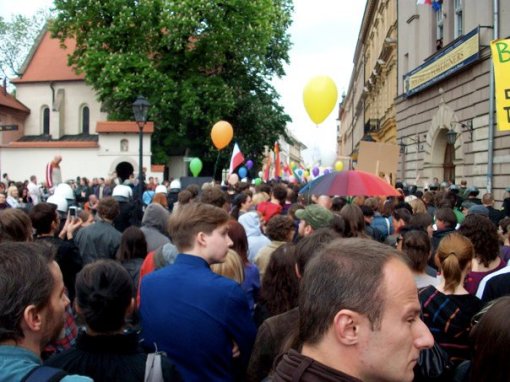

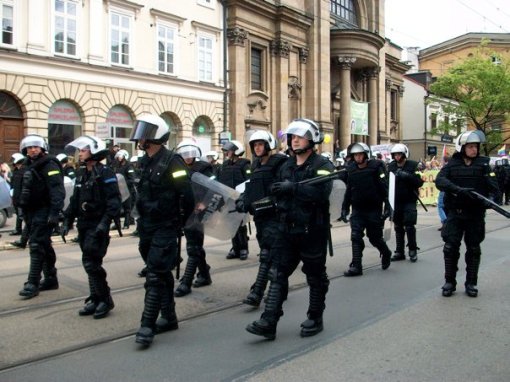


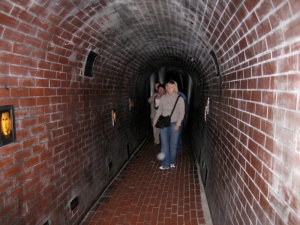
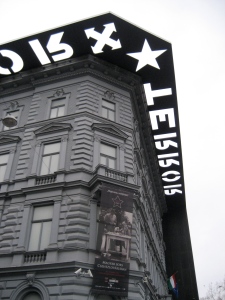 Facade of House of Terror, Budapest Hungary (no photography allowed inside museum)
Facade of House of Terror, Budapest Hungary (no photography allowed inside museum)

